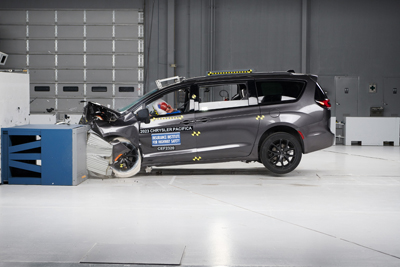Popular with parents, minivans ought to boast the safest second-row seating on the market. Instead, they’re lagging behind.
None of the four minivans tested by the Insurance Institute for Highway Safety earned an acceptable or good rating in the updated moderate overlap front crash test, which now emphasizes back seat safety. The Chrysler Pacifica, Kia Carnival and Toyota Sienna are rated marginal, while the Honda Odyssey is rated poor.
All but the Sienna also lack seat belt reminders for the second-row seats, as IIHS highlighted in February.
“Back seat safety is important for all vehicles, but it’s especially vital for those, like minivans, that customers are choosing specifically to transport their families,” said IIHS President David Harkey. “It’s disappointing that automakers haven’t acted faster to apply the best available technology to the second row in this vehicle class.”
IIHS launched the updated moderate overlap front test last year after research showed that in newer vehicles the risk of a fatal injury is now higher for belted occupants in the second row than for those in front. This is not because the second row has become less safe. Rather, the front seat has become safer because of improved airbags and advanced seat belts that are rarely available in back.
Even with these developments, the back seat remains the safest place for children, who can be injured by an inflating front airbag, and the rating does not apply to children secured properly in child safety seats.
In the updated test, a second dummy is positioned in the second row behind the driver. The driver dummy is the size of an average adult man. The rear dummy is the size of a small woman or 12-year-old child. IIHS researchers also developed new metrics that focus on the injuries most frequently seen in back seat passengers.
For a vehicle to earn a good rating, there can’t be an excessive risk of injury to the head, neck, chest or thigh, as recorded by the second-row dummy. The dummy should remain correctly positioned during the crash without “submarining,” or sliding forward beneath the lap belt, which increases the risk of abdominal injuries. The head should also remain a safe distance from the front seatback and the rest of the vehicle interior, and the shoulder belt should remain on the shoulder, where it is most effective. A pressure sensor on the rear dummy’s torso is used to check the shoulder belt position during the crash.
As in the original test, the structure of the occupant compartment must maintain adequate survival space for the driver, and measurements taken from the driver dummy shouldn’t show an excessive risk of injuries.
All four minivans provide good protection in the front seat. But each is plagued by multiple issues when it comes to the second row.
“The restraint systems in all four vehicles leave the second-row occupant vulnerable to chest injuries, either because of excessive belt forces or poor belt positioning,” said Jessica Jermakian, IIHS vice president of vehicle research. “That’s concerning, because those injuries can be life-threatening.”
Of the four vehicles, only the marginal-rated Sienna is equipped with belt pretensioners and force limiters, technologies designed to reduce belt forces. However, the rear dummy submarined beneath the lap belt and the shoulder belt migrated off the shoulder toward the dummy’s neck during the test.
In the two other marginal vehicles, the Carnival and Pacifica, the seat belt exerted too much force on the dummy’s chest. The side curtain airbag of the Pacifica also did not deploy during the test.
The forces on the rear dummy’s neck were within reasonable limits in the Pacifica and Sienna but substantially higher in the Carnival, increasing the chances of a head or neck injury.
In the poor-rated Odyssey, the forces on the head and neck were higher still, and the crash video demonstrated the rear seat belt allowed the dummy’s head to come too close to the front seatback, which also increases the risk of head injuries.










Abby Andrews